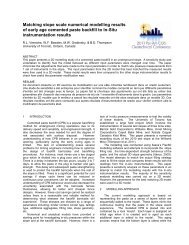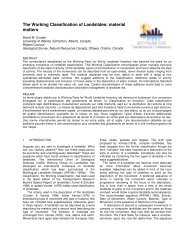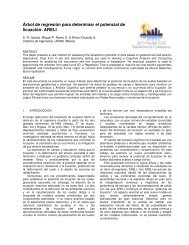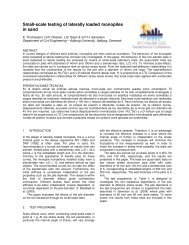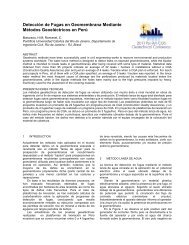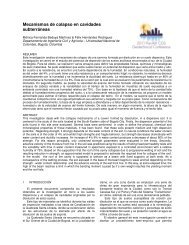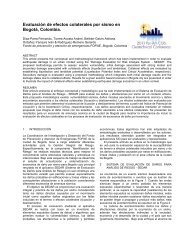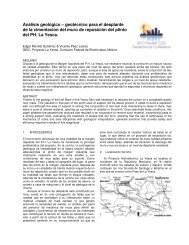Design Recommendation for Stone Column Reinforced Soft Clay ...
Design Recommendation for Stone Column Reinforced Soft Clay ...
Design Recommendation for Stone Column Reinforced Soft Clay ...
You also want an ePaper? Increase the reach of your titles
YUMPU automatically turns print PDFs into web optimized ePapers that Google loves.
The smear zone parameters, viz. r s and k s may be<br />
reasonably estimated following the recommendations of<br />
Han et al. (2002), Walker et al. (2006) and Wang (2009),<br />
where, r s and k s are the radius and the horizontal<br />
permeability of soil in the smear zone respectively. The<br />
clogging effect was quantified by the non-dimensional<br />
parameters α and α k. Because of the different column to<br />
soil stiffness ratio, the soil arching beneath the<br />
embankment occurs. Following the analysis of Abusharar<br />
et al. (2009), the arching effect was analysed to compute<br />
the vertical stress distribution q(r) on the ground surface<br />
which was found to be parabolic and a unique function of<br />
N (=r e/r c), n s, r c, r, q and K p (passive earth pressure<br />
coefficient of the embankment). The term n s, referred as<br />
the stress concentration ratio, was defined as the ratio of<br />
stiffness between soft soil and stone columns and a<br />
function of height of embankment, properties of the soils<br />
in the embankment and that of the soft clay deposit. The<br />
values of n s can be reasonably estimated following the<br />
recommendations Castro et al. (2009).<br />
The nodal excess pore pressures were computed<br />
based on the radial consolidation theory of Barron (1948).<br />
Using appropriate boundary conditions, the following<br />
matrix equation was evaluated:<br />
A { u}<br />
{ b}<br />
……(1)<br />
where, A coefficient matrix; {u}<br />
unknown vector<br />
<strong>for</strong> excess pore water pressure at nodes; {b}<br />
augment<br />
vector.<br />
Solving the Equation (1), the nodal excess pore<br />
pressures, and hence the degree of consolidation, were<br />
computed. The nodal displacements within the soil mass<br />
of the unit cell at time t was given as:<br />
t z<br />
u( r,<br />
z)<br />
……(2)<br />
m<br />
v<br />
0 0<br />
t<br />
dzdt<br />
The nodal and average ground settlements were<br />
computed by carrying out numerical integration.<br />
The effective stress developed in the soil mass at any<br />
point (r, z, t) in the space-time coordinate may be<br />
expressed by (Khan et al., 2010):<br />
r , z,<br />
t z q(<br />
r)<br />
u(<br />
r,<br />
t)<br />
……(3)<br />
where, γ’ is the effective unit weight of the soil mass.<br />
During consolidation, the undrained strength and<br />
stiffness of the soil increase progressively. Guetif et al.<br />
(2007) carried out extensive finite element analysis to<br />
investigate the improved soft clay characteristics due to<br />
stone column installation. The undrained cohesion at any<br />
point in the space-time coordinate system was computed<br />
following the analysis of Umezaki et al. (1993). The<br />
increased soil strength was quantified by a nondimensional<br />
improvement factor β which was defined as<br />
the minimum value of the ratio of the post-consolidation<br />
to initial undrained cohesion at ground surface. Similarly,<br />
the increase in stiffness of the soft soil was expressed as<br />
a settlement factor ξ defined as the ratio of the average<br />
ground settlements of the rein<strong>for</strong>ced to unrein<strong>for</strong>ced soils<br />
at 90% consolidation.<br />
For design purpose, a modified time factor T’ 90 has<br />
been introduced herein, which is expressed as:<br />
T’ 90= c vr t 90 / H 2 ……(4)<br />
where, t 90 is the time required <strong>for</strong> the average degree of<br />
consolidation to attain 90% and c vr = coefficient of radial<br />
consolidation of the soil = k h / (m v γ w ), γ w being the unit<br />
weight of water. Since both r c and r e are variables, the<br />
constant parameter H is used <strong>for</strong> normalizing the time.<br />
The computation was carried out by means of a userfriendly<br />
computer software written in FORTRAN 90<br />
language. The relevant flowchart is shown in Fig.3.<br />
Start<br />
Input soil data, column parameters,<br />
imposed load and time<br />
Compute excess pore water pressures<br />
developed in the soil <strong>for</strong> all values of i and k<br />
Compute effective stresses<br />
induced in the soil <strong>for</strong> all values of r, z and t<br />
Compute nodal displacement<br />
of soil at all nodal points<br />
Compute undrained shear strength<br />
<strong>for</strong> all values of r, z and t<br />
Compute improvement factor and<br />
settlement factor <strong>for</strong> all t<br />
Print output results<br />
Stop<br />
Figure 3. Flowchart <strong>for</strong> the computer program.<br />
3 VALIDATION<br />
Comparison of the average degree of consolidation by<br />
radial drainage only has been made with the existing<br />
solutions of Barron (1948), Hansbo (1981), Han et al.<br />
(2000 & 2002) and Wang (2009). The variations of<br />
average degree of consolidation with time factor are<br />
presented in Fig.4. It was observed that the results<br />
obtained using the present model are in acceptable<br />
agreement with the other solutions and close to those of<br />
Han et al. (2002).<br />
Redana (1999) analysed the per<strong>for</strong>mance of two test<br />
embankments T1 and T2 constructed at a naval dockyard<br />
of Pom Prachul, Thailand. For improvement of soft<br />
ground, sandwitch drains were installed in a square




